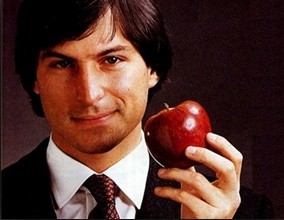CHAPTER TEN
第十章
THE MAC IS BORN
Mac诞生了
You Say You Want a Revolution
你说你想要一场革命
Jef Raskin’s Baby
杰夫拉斯金的宝贝
Jef Raskin was the type of character who could enthrall Steve Jobs—or annoy him. As it turned out, he did both. A philosophical guy who could be both playful and ponderous, Raskin had studied computer science, taught music and visual arts, conducted a chamber opera company, and organized guerrilla theater. His 1967 doctoral thesis at U.C. San Diego argued that computers should have graphical rather than text-based interfaces. When he got fed up with teaching, he rented a hot air balloon, flew over the chancellor’s house, and shouted down his decision to quit.
杰夫·拉斯金是那种能让史蒂夫·乔布斯着迷——或者是厌烦的人。事实证明,两者他都做到了。拉斯金是个很有哲学家范儿的人,有时幽默顽皮,有时又呆板沉闷,他学习过计算机科学,教过音乐和视觉艺术,管理过一家室内歌剧院,还组织过街头剧场。他1967年在加州大学圣迭戈分校完成的博士论文中提出,计算机应该拥有图形界面,而不是基于文本的界面。他在厌倦了教书之后,就租了一只热气球,飞到校长家上空,大声喊出了自己的辞职决定。
When Jobs was looking for someone to write a manual for the Apple II in 1976, he called Raskin, who had his own little consulting firm. Raskin went to the garage, saw Wozniak beavering away at a workbench, and was convinced by Jobs to write the manual for $50. Eventually he became the manager of Apple’s publications department. One of Raskin’s dreams was to build an inexpensive computer for the masses, and in 1979 he convinced Mike Markkula to put him in charge of a small development project code-named “Annie” to do just that. Since Raskin thought it was sexist to name computers after women, he redubbed the project in honor of his favorite type of apple, the McIntosh. But he changed the spelling in order not to conflict with the name of the audio equipment maker McIntosh Laboratory. The proposed computer became known as the Macintosh.
1976年,乔布斯找人为AppleII编写操作手册,他给当时已经拥有一家小型咨询公司的拉斯金打了电话。拉斯金来到乔布斯的车库,看到了在工作台上埋头苦干的沃兹尼亚克,并被乔布斯说服,接受了以50美元的报酬为他们编写操作手册。后来,拉斯金成为了苹果公司出版部门的全职经理。他有一个梦想,就是为大众制造价格低廉的电脑。1979年,他说服了迈克·马库拉,成为了小规模项目“安妮”的负责人。然而拉斯金认为,用女人的名字命名电脑是带有性别歧视成分的,所以他更换了项目代号,用的是自己最喜欢的一种苹果的名字:麦金托什(McIntosh)。但为了避免与音频设备制造商麦金托什实验室(McIntoshLaboratory)的名字有冲突,他故意改变了字母的拼写。于是,新电脑的名字变成了麦金塔(Macintosh)。
Raskin envisioned a machine that would sell for $1,000 and be a simple appliance, with screen and keyboard and computer all in one unit. To keep the cost down, he proposed a tiny five-inch screen and a very cheap (and underpowered) microprocessor, the Motorola 6809. Raskin fancied himself a philosopher, and he wrote his thoughts in an ever-expanding notebook that he called “The Book of Macintosh.” He also issued occasional manifestos. One of these was called “Computers by the Millions,” and it began with an aspiration: “If personal computers are to be truly personal, it will have to be as likely as not that a family, picked at random, will own one.”
拉斯金预想中的电脑售价1000美元,像家用电器一样操作简单,并且将屏幕、键盘和电脑本身整合为一体。为了降低成本,他计划使用5英寸的小屏幕,以及非常便宜(性能也很落后)的微处理器——摩托罗拉6809。拉斯金自诩为哲学家,他不断地把自己的想法记录在本子上,称之为“麦金塔之书”。他还会偶尔发表一些宣言,其中之一叫做“数以百万计的电脑”,开头就表达了他远大的志向:“如果个人电脑能真正走向每个人的话,那么任何一个家庭都应该拥有一台。”
Throughout 1979 and early 1980 the Macintosh project led a tenuous existence. Every few months it would almost get killed off, but each time Raskin managed to cajole Markkula into granting clemency. It had a research team of only four engineers located in the original Apple office space next to the Good Earth restaurant, a few blocks from the company’s new main building. The work space was filled with enough toys and radio-controlled model airplanes (Raskin’s passion) to make it look like a day care center for geeks. Every now and then work would cease for a loosely organized game of Nerf ball tag. Andy Hertzfeld recalled, “This inspired everyone to surround their work area with barricades made out of cardboard, to provide cover during the game, making part of the office look like a cardboard maze.”
从1979年到1980年初,麦金塔项目一直处于奄奄一息的状态。每隔几个月,它就会面临被解散的命运,但每一次拉斯金都能让马库拉善心大发,项目便能得以延续。它的研究团队只有4名工程师,办公地点在苹果公司以前的办公楼,紧邻美好地球餐厅,跟公司新建的主楼隔了几个街区。办公室里堆满了玩具和无线电遥控的飞机模型(拉斯金的最爱),看上去就像个为极客们服务的日托中心。大家会时不时地停下手中的工作,玩一场组织松散的Nerf球游戏。正如安迪·赫茨菲尔德回忆的:“这让大家都在自己的办公区域四周围上了纸板做成的挡板,以便在游戏的时候提供遮挡,这么一来,办公室看上去就像个用纸板围成的迷宫。”
The star of the team was a blond, cherubic, and psychologically intense self-taught young engineer named Burrell Smith, who worshipped the code work of Wozniak and tried to pull off similar dazzling feats. Atkinson discovered Smith working in Apple’s service department and, amazed at his ability to improvise fixes, recommended him to Raskin. Smith would later succumb to schizophrenia, but in the early 1980s he was able to channel his manic intensity into weeklong binges of engineering brilliance.
团队中的明星是一个叫伯勒尔·史密斯(BurrellSmith)的无师自通的年轻工程师。他有一头金发,长着一张娃娃脸,内心却极其严肃认真,他十分崇拜沃兹尼亚克编写的代码,自己也想做出一些耀眼的成就。阿特金森在苹果的服务部门发现了在那里工作的史密斯,惊叹于他随时想出补救方法的能力,于是将他推荐给了拉斯金。史密斯后来饱受精神分裂症的折磨,但9在20世纪80年代初期,他还是将自己疯狂的热情投入到不分节假日的工作中,并展现了完美的工程天赋。
Jobs was enthralled by Raskin’s vision, but not by his willingness to make compromises to keep down the cost. At one point in the fall of 1979 Jobs told him instead to focus on building what he repeatedly called an “insanely great” product. “Don’t worry about price, just specify the computer’s abilities,” Jobs told him. Raskin responded with a sarcastic memo. It spelled out everything you would want in the proposed computer: a high-resolution color display, a printer that worked without a ribbon and could produce graphics in color at a page per second, unlimited access to the ARPA net, and the capability to recognize speech and synthesize music, “even simulate Caruso singing with the Mormon tabernacle choir, with variable reverberation.” The memo concluded, “Starting with the abilities desired is nonsense. We must start both with a price goal, and a set of abilities, and keep an eye on today’s and the immediate future’s technology.” In other words, Raskin had little patience for Jobs’s belief that you could distort reality if you had enough passion for your product.
乔布斯十分赞赏拉斯金的想象力,但并不同意他为了降低成本而牺牲产品性能。1979年秋的一天,乔布斯告诉拉斯金,集中精力把他反复念叨的“终极完美”的产品做好就行。“你不用担心价格,把电脑的性能列出来。”乔布斯吿诉他。作为回应,拉斯金送上了一份充满讽刺的备忘录。其中列出了当时所有人梦寐以求的功能:每行可显示96个字符的高分辨率彩色屏幕,无需使用色带、能以每秒1页的速度打印所有彩色图像的打印机,可以不受限地访问ARPA(美国国防部髙级研究计划署)网络,还能够识别语音和合成音乐,“甚至可以模拟卡鲁索与摩门大教堂合唱团共同演唱并伴有各种混音效果的场景”。备忘录最后总结道:“一切只从性能出发是毫无意义的。我们必须设定一个价格目标和相应的一系列性能,同时还必须关注当下以及不远的未来的科技。吣换句话说,乔布斯认为只要对产品有足够的热情就可以扭曲现实,但拉斯金对此并不认同。














